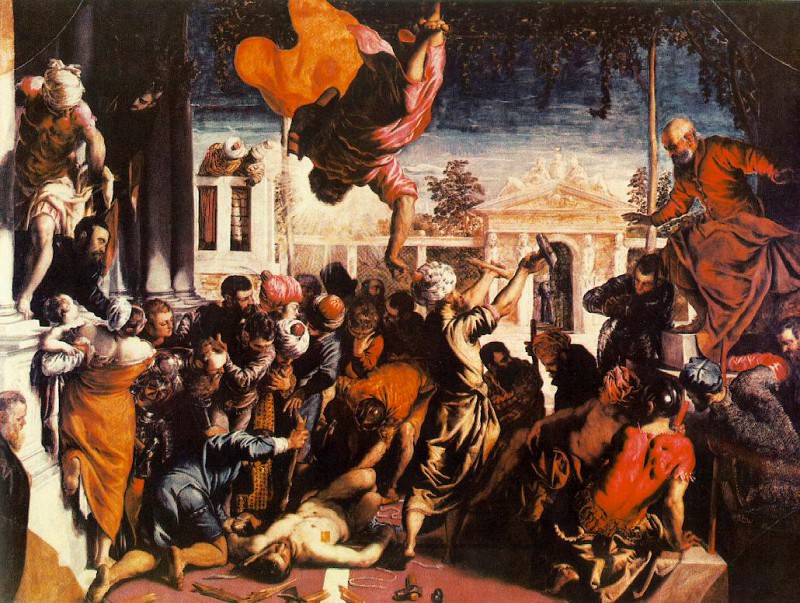The Miracle of St Mark Freeing the Slave WGA Tintoretto (Jacopo Robusti) (1518-1594)
Tintoretto – The Miracle of St Mark Freeing the Slave WGA
Edit attribution
Download full size: 1030×776 px (0,2 Mb)
Painter: Tintoretto (Jacopo Robusti)
The painting depicts the occurrence of a miracle. When the early Christians spread their faith throughout the world, it often happened that pagans were unwilling to listen to them. Thus one of the young apostles fell into the hands of a cruel king who laughed at him and sentenced him to be quartered. But when the executioners carried out the sentence, they found that the young man’s body had become invulnerable to axes, and the executioners were horrified and believed. The painting depicts the moment when people realize that something wrong is happening, something that should not be happening. The preacher is lying on the rocks, his eyes closed, and around him are the splinters that are left from the weapons.
Description of Tintoretto’s Miracle of St. Mark
The painting depicts the occurrence of a miracle. When the early Christians spread their faith throughout the world, it often happened that pagans were unwilling to listen to them. Thus one of the young apostles fell into the hands of a cruel king who laughed at him and sentenced him to be quartered. But when the executioners carried out the sentence, they found that the young man’s body had become invulnerable to axes, and the executioners were horrified and believed.
The painting depicts the moment when people realize that something wrong is happening, something that should not be happening.
The preacher is lying on the rocks, his eyes closed, and around him are the splinters that are left from the weapons. All around him are stunned people. One of the executioners, swarthy-skinned, in a turban, shows the people on raised hands an axe and an axe, while the others are on their knees with their faces on the ground, and there is movement all around. People are reaching out to see the miracle that has taken place. The composition is typical of Renaissance paintings - it is clearly geometric.
Its center is static and defined by the reclining body. On the left and right sides motion enlivens the picture, makes it dynamic, balances the statics. Uncharacteristic only is the abrupt movement of St. Mark from top to bottom, his outstretched hand. He appears out of nowhere, his head shining with light, his clothes fluttering around him, and his very movement seems to break up the composition, depriving it of integrity, and at the same time strangely balancing it.
Faith triumphs. In the distance you can see mountains and a museum with statues, you can see a tree and a very pale blue sky transitioning into a pre-thunderous heaviness.
The miracle does not look cheerful or joyful. It is filled with a frightening meaning, calling not to love God, but to submit to him. It is not to fall upon the edge of the
of the garments in awe and awe, but to bury our foreheads in the dust on our knees.
This miracle is the triumph of Christianity over paganism, but there is something threatening and oppressive in the picture itself.
Кому понравилось
Пожалуйста, подождите
На эту операцию может потребоваться несколько секунд.
Информация появится в новом окне,
если открытие новых окон не запрещено в настройках вашего браузера.
You need to login
Для работы с коллекциями – пожалуйста, войдите в аккаунт (open in new window).










![Tintoretto (Jacopo Robusti) - The Annunciation [Workshop]](http://cdn.gallerix.asia/j/T/691884944/3027.webp)









You cannot comment Why?
Perhaps it’s a painting of a group of people standing in front of.